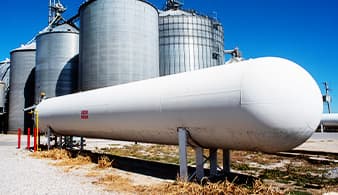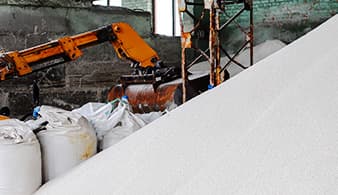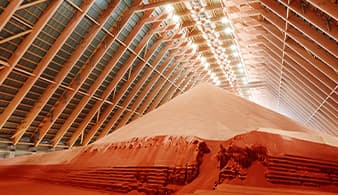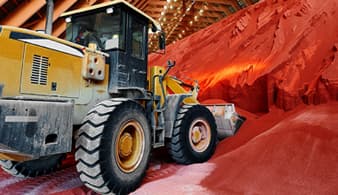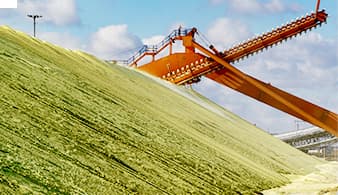

Fertilizers
Overview
The fertilizer industry has seen dramatic changes in market dynamics, with challenges posed by policy and regulatory changes, political instability, conflicts and new macroeconomic realities. The drive towards energy transition and ambitious zero-carbon goals has also opened up the industry to new entrants and new opportunities.
It is more vital than ever for market participants to have the full picture – to capitalise on the opportunities and manage the risk of the challenges.
Argus’ fertilizer market intelligence will empower you to work smarter:
- Our price reporting services provide robust daily and weekly price assessments, market moving news, actionable market commentary and proprietary data
- Our short-term outlook and medium to long-term analytics services connect you with industry-leading forecasts and analysis of prices, supply, demand, costs, trade and projects
- Our consulting services partner with you to deliver fully bespoke consulting solutions, including market-specific research and analysis
Our market coverage
Argus is the leading independent provider of market intelligence to the global fertilizer market.
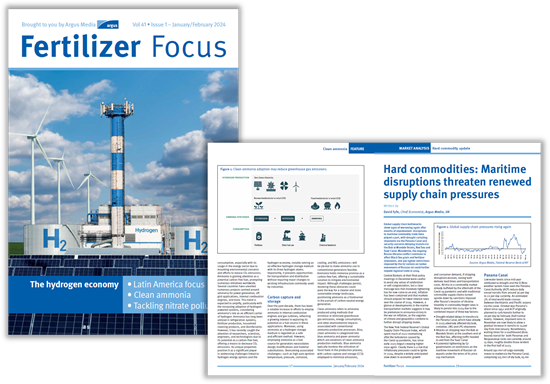
Fertilizer Focus Magazine – sign up here
Get complimentary access to Argus Fertilizer Focus, our bi-monthly magazine focused on traditional fertilizer commodities and specialty fertilizers. Each issue delivers a great blend of news, features, interviews and unique insights into all aspects of the fertilizer industry.
Sign up hereLatest fertilizer news
Browse the latest market moving news on the global fertilizer industry.
Low US natgas prices help ammonia economics
Low US natgas prices help ammonia economics
Houston, 8 May (Argus) — Nitrogen fertilizer production costs in the US are primed to hit historically low levels through the third quarter, potentially creating favorable margin and arbitrage opportunities during the offseason as bloated natural gas inventories depress key feedstock prices. Estimated ammonia production costs for most US producers tied to Henry Hub natural gas prices have spent the last 12 consecutive weeks below $100/short ton (st) on sub-$2/mmBtu feedstock prices. They should benefit from sub-$3/mmBtu natural gas costs through October, based on the 7 May Nymex futures curve. A mild winter stemmed seasonal withdrawals from natural gas storage and mitigated heating demand. US natural gas inventories exited the 2023-24 winter at the highest seasonal levels in eight years. High inventories help contain US gas prices by easing concerns about spikes in demand or supply shortfalls. Slackened natural gas demand has continued through April and has maintained downward price pressure, even as producers curtail output. The US Energy Information Administration (EIA) said that it expects inventory growth to lag average levels in the coming months as producers cut output in response to lower prices. But inventories were still expected to exit the injection season, when gas stockpiles are replenished to meet winter heating needs, at an all-time high above 4.1 Tcf, the EIA said. Natural gas is the primary feedstock for US ammonia producers, comprising on average 60-70pc of total production costs at current prices. Ammonia production costs have not spent this long below $100/st since May-July 2020, according to Argus data. Ammonia is a key feedstock for urea and UAN manufacturing. Sinking feedstock ammonia costs lowers the cost floor for upgraded nitrogen alternatives and fosters favorable margin opportunities. US producer CF Industries said during its first quarter results the energy curves between North America and Europe — with the latter a higher-cost ammonia production hub — remain wider than historical levels, creating potential arbitrage scenarios. Ammonia production costs based on the Dutch TTF natural gas day-ahead contract, which serves as the European benchmark, have averaged more than three-times more than those tied to Henry Hub since January, according to Argus data. "Longer term, we expect the global energy cost structure to continue to provide significant margin opportunities for our North American production network," CF chief executive Tony Will said during the company's earnings call. By Connor Hyde Send comments and request more information at feedback@argusmedia.com Copyright © 2024. Argus Media group . All rights reserved.
Pakistan's ECC approves urea imports of 200,000t
Pakistan's ECC approves urea imports of 200,000t
Amsterdam, 8 May (Argus) — Pakistan's Economic Coordination Committee (ECC) met on 7 May and has approved the import of 200,000t of urea for the Kharif summer season. The ECC did not disclose an exact timeline, but a tender will have to be issued shortly if the imports are to meet demand in Kharif, which runs from April to September with demand peaking in June-July. Pakistan occasionally enters the import market to plug supply gaps in key consumption periods. State-owned importer TCP previously agreed a deal with Azerbaijan's state-owned Socar in early December last year to source 200,000t of urea for arrival by 20 January. Domestic supplier Engro began maintenance at its 1.3mn t/yr granular urea Enven plant towards the end of April and is expected to return to production in mid-June. Pakistan's urea inventories started April at around 170,000t, but are set to be under significant pressure in June-July, data from the country's national fertilizer development centre (NFDC) show. Demand is set to hit over 800,000t in June and around 650,000t in July, outstripping typical domestic output of 520,000-555,000 t/month in the peak summer months. This has prompted the need for imports, given current stock levels. By Harry Minihan Send comments and request more information at feedback@argusmedia.com Copyright © 2024. Argus Media group . All rights reserved.
Chile’s 1Q24 sulacid imports drop 19pc on port closures
Chile’s 1Q24 sulacid imports drop 19pc on port closures
London, 7 May (Argus) — Chile's sulphuric acid imports in the first quarter fell by 19pc on the previous quarter owing to heavy swells at Mejillones port. A total of 875,000t of sulphuric acid was imported in January-March, down by 19pc from 1.08mn t in October-December last year, GTT data show. They were also down by 15pc on the year. The drop was mainly down to heavy disruption at Mejillones, Chile's main import hub for sulphuric acid. The port, which hosts three sulphuric acid discharge terminals, was shut for a record 40 days in January-March owing to heavy swells. The port closures led to lengthy waiting times to discharge, with some ships experiencing nearly 3-4 weeks from arrival at the port, which resulted in high demurrage costs and a lack of spot demand. China regained its position as the key supplier to Chile, with imports rising by 19pc to 342,200t in the quarter, as Asian-origin cargoes looked economically viable owing to sliding fob values, while freight rates remained firm. Imports from South Korea rose by 34pc on the quarter to 145,300t, while Japanese shipments rose by 14pc to 114,300t. Chinese fob values averaged $16/t on a midpoint basis during the quarter, down from $32/t fob on a midpoint basis in the fourth quarter of last year. South Korea/Japanese fob values averaged $8/t on a midpoint basis during the first quarter, down from $31/t the previous quarter. Imports from neighbouring Peru dropped by 34pc on the quarter on a combination of logistical issues stemming from the congestion at Mejillones and some unplanned output issues faced earlier in the year by a supplier in Peru. Imports from European countries continued to slow in the first quarter, falling by nearly 60pc on the prior quarter, as heavy buying by key Moroccan buyer OCP and transport restrictions through the Panama Canal affected trade flows. Belgium was the largest European supplier to Chile, shipping 33,000t, compared with 86,000t the previous quarter. By Lili Minton Send comments and request more information at feedback@argusmedia.com Copyright © 2024. Argus Media group . All rights reserved.
Canadian rail workers vote to launch strike: Correction
Canadian rail workers vote to launch strike: Correction
Corrects movement of grain loadings from a year earlier in final paragraph. Washington, 2 May (Argus) — Workers at the two major Canadian railroads could go on strike as soon as 22 May now that members of the Teamsters Canada Rail Conference (TCRC) have authorized a strike, potentially causing widespread disruption to shipments of commodities such as crude, coal and grain. A strike could disrupt rail traffic not only in Canada but also in the US and Mexico because trains would not be able to leave, nor could shipments enter into Canada. This labor action could be far more impactful than recent strikes because it would affect Canadian National (CN) and Canadian Pacific Kansas City (CPKC) at the same time. Union members at Canadian railroads have gone on strike individually in the past, which has left one of the two carriers to continue operating and handle some of their competitor's freight. But TCRC members completed a vote yesterday about whether to initiate a strike action at each carrier. The union represents about 9,300 workers employed at the two railroads. Roughly 98pc of union members that participated voted in favor of a strike beginning as early as 22 May, the union said. The union said talks are at an impasse. "After six months of negotiations with both companies, we are no closer to reaching a settlement than when we first began, TCRC president Paul Boucher said. Boucher warned that "a simultaneous work stoppage at both CN and CPKC would disrupt supply chains on a scale Canada has likely never experienced." He added that the union does not want to provoke a rail crisis and wants to avoid a work stoppage. The union has argued that the railroads' proposals would harm safety practices. It has also sought an improved work-life balance. But CN and CPKC said the union continues to reject their proposals. CPKC "is committed to negotiating in good faith and responding to our employees' desire for higher pay and improved work-life balance, while respecting the best interests of all our railroaders, their families, our customers, and the North American economy." CN said it wants a contract that addresses the work life balance and productivity, benefiting the company and employees. But even when CN "proposed a solution that would not touch duty-rest rules, the union has rejected it," the railroad said. Canadian commodity volume has fallen this year with only rail shipments of chemicals, petroleum and petroleum products, and non-metallic minerals rising, Association of American Railroads (AAR) data show. Volume data includes cars loaded in the US by Canadian carriers. Coal traffic dropped by 11pc during the 17 weeks ended on 27 April compared with a year earlier, AAR data show. Loadings of motor vehicles and parts have fallen by 5.2pc. CN and CPKC grain loadings fell by 4.3pc from a year earlier, while shipment of farm products and food fell by 9.3pc. By Abby Caplan Send comments and request more information at feedback@argusmedia.com Copyright © 2024. Argus Media group . All rights reserved.
Spotlight content
Browse the latest thought leadership produced by our global team of experts.
Explore our fertilizer products
Key price assessments
Argus prices are recognised by the market as trusted and reliable indicators of the real market value. Explore some of our most widely used and relevant price assessments.
Related events
Argus Fertilizer Caspian, Black Sea and Eastern European Markets
Argus Fertilizer Caspian, Black Sea and Eastern European Markets
Argus DEF Forum North America
Argus DEF Forum North America
Argus Fertilizer Europe Conference
Argus Fertilizer Europe Conference


